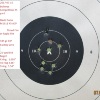Thanks for the replies all. I have some things to think about, but the feel I'm getting here is that for the type of ammo I'm making, it is not likely to be an issue I need to be too concerned with.
Since you are loading lighter practice load, using shorter OAL will likely produce higher more consistent chamber pressures from greater neck tension, less bullet setback and less bullet seating depth variance. Keep in mind, actual chamber pressures and resulting accuracy depend on "chambered OAL/bullet seating depth" and not "finished OAL/bullet seating depth".
That's a good point. My practice ammo gets chambered once and then shot, so I doubt bullet setback will be an issue for me, but none the less, I hear what you are saying.
I bell my casings as little as possible, so I'm not just beating my brass up. When I set my crimp die, it seemed pretty near perfect with minor tweaking. The end result is cartridges that look the same as factory ammo. However, what I will do when I get a chance to shoot some of these is measure the OAL, which is consistent at the max of 1.275", chamber one round as if I was going to fire, eject it, and then re-measure it. If there is any significant setback, I'll adjust my crimp as much as I can without screwing up my head spacing.
As a new reloader, I didn't realize the wide margins and differences in data that can exist from one loading manual to another. Awhile ago I noted a difference in velocities of max loads of Unique in the Hornady and Lyman manuals. One had higher volume being listed as a max than the other, and the velocities were quite different. As I studied the data closer, I realized the seating depths were entirely different and the pressure difference between the two had to be the reason why.
It seems like if I decide to shorten my cartridges a tad, to ensure there is no premature riffling contact or lockups, that as long as I keep it in-between published max loads and only modify the seating depth slightly, I should be fine, correct? Obviously I need to chrony my loads to make sure I don't have an over pressure situation, but it seems logical.








